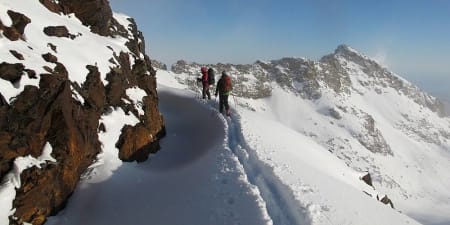Jens Foell combines ski touring and mountaineering in the Sierra Nevada combating very cold and icy conditions, knife edge ridges and finishing in the dark
Jens continues.................
Three days later we had two guests from Ireland, Richard and John, who’d come for some ski touring. After seeing the pictures of the Raspones they decided to give the ridge a go as well. So we made quite an ambitious plan: ascend Pico Veleta (3394m) from the North on skis, cross over and descend to the Poqueira hut.
"This year we had a big drop in temperature here in the Sierra Nevada at the end of November. This led to two very different experiences up in the high mountains only days apart from each other. The first trip was a Spanish Highs Team ascent of the Raspones ridge, a beautiful alpine style summit ridge rising up from 2800m to well above 3000m (see article by Ian Tupman). We had great weather, in fact it probably was too nice to call the ascent a winter climb as there was hardly any snow left on the ridge. No wind and blue skies meant that one could fully concentrate on the rewarding climb and views. Even camping right in the snow didn't feel all that cold. Personally I felt very elated after the two day trip and couldn't wait to get back up the mountains.
All photos courtesy of Richard Jones and John O'Connor
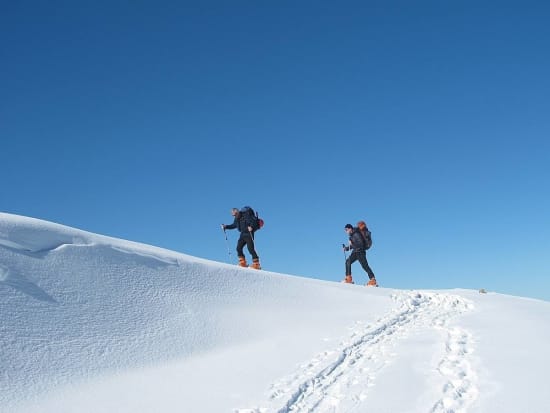
fantastic snow and blue skies to start with
Three days later we had two guests from Ireland, Richard and John, who’d come for some ski touring. After seeing the pictures of the Raspones they decided to give the ridge a go as well. So we made quite an ambitious plan: ascend Pico Veleta (3394m) from the North on skis, cross over and descend to the Poqueira hut. Then climb the Raspones ridge on the second day and cross back over to the Ski station on the third. Initially we had even planned on bivouacking above 3000m, but when it became obvious how cold it was going to be we opted for the hut instead. Nevertheless, we had to carry a rope, climbing gear, and mountain boots as well as everything else you need for 3 days in the mountains on our backs as we skied up towards Veleta.
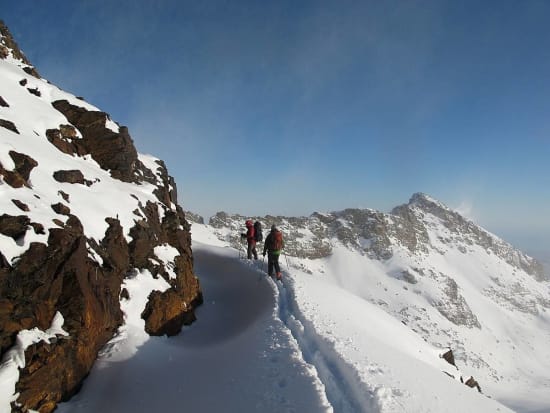
Paso de Cerro de los Machos
The ascent of Veleta took us a fair while and once near the summit we encountered very strong icy winds that were saturated with fresh powder snow from the night before. We sheltered at the little, unmanned Cariguela Refugio (3200m) before crossing over to the southern side of the Sierra. Three days earlier this route would have been straightforward but now it had changed dramatically with the new snow. We had to either traverse along steep icy slopes or fight our way through deep snow drifts, sinking in up to our knees even though we were on skis. Add to that our exhaustion from climbing up with heavy packs, the extreme cold, and strong gusts of wind that constantly threatened to knock us over, and we were in for an epic afternoon.
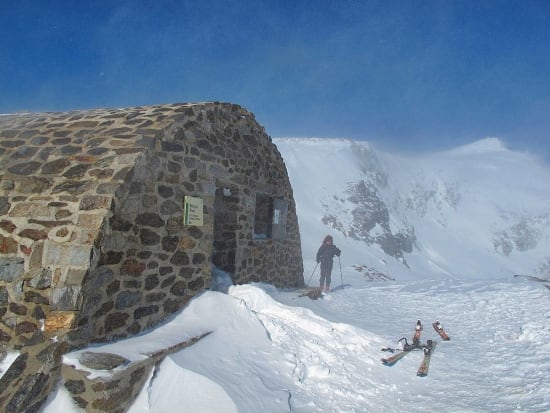
Refugio Carihuela in windy conditions
Progress was very slow, so we only just about made it to a position from where we could ski down towards the Poqueira hut at nightfall. And whilst battling with the icy wind (I'd estimate the wind chill at -20C or lower) the skins kept coming of my skis so I had to keep taking my gloves off to sort them out. My finger tips still haven’t regained full feeling now, 4 days later. After the easy going trip a few days earlier, being confronted with the hardship that cold and weather can bring in the high mountains was yet again a humbling experience.
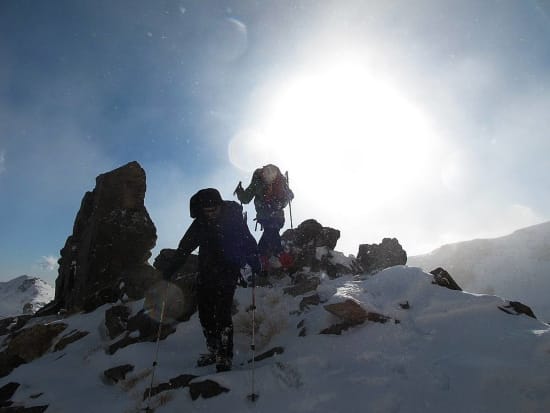
Icy cold winds
In the end we had to ski down in the semi dark, stash our skis in a rocky gully from where we could only carry on by foot. Cramponing across ice and snow in the pitch black, we arrived at the hut 1 1/2h after dark. The caretaker, who’d known that we were on our way, had been very worried due to the extreme cold, so he was just as happy to see us as we were to see him. The hut food has never tasted as good and the beds have never felt as comfortable as they did that night.
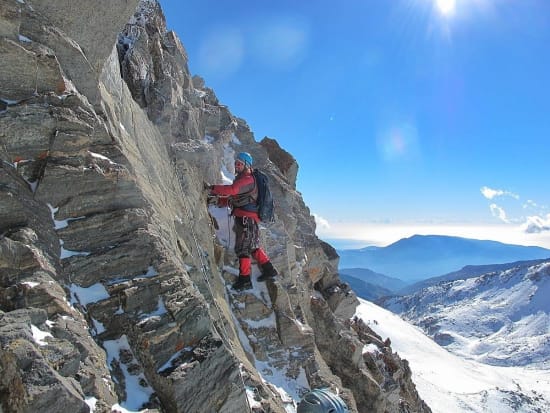
On the Raspones ridges
After that first epic day we didn't set off too early the next morning. We also had to go back to where we had left our skis to collect John’s skins, forgotten during the drama of the night before. So it was already midday by the time we started on the Raspones ridge, a fantastic alpine route. The climb itself was once again a great experience. There was more snow now, so some of the traverses had become a bit more tricky, but we were lucky in that the wind had let off and we once again had great views under blue skies.
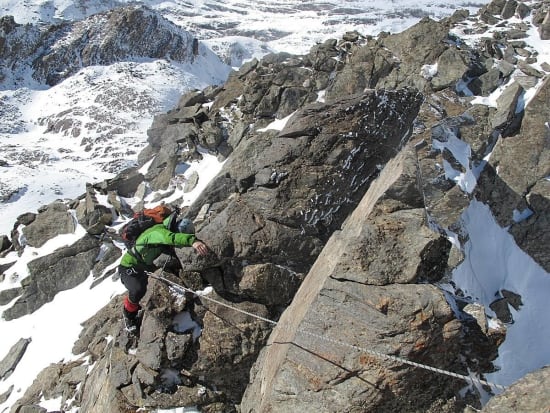
A tricky section of the ridge
The three of us had a great time but we could not go as far as I'd done a few days earlier as there was not enough time. So we left the ridge by abseiling and then down-climbed into the neighboring valley of the Rio Veleta. This time we made it back to the hut whilst the sun was still up, grateful for a wonderful day.

On the central section of Raspones ridge
However, that night we could here strong winds rattling the hut’s roof, and setting off early to avoid the bad weather that was forecast for the afternoon, we climbed back up to our skis with a feeling of trepidation. Trying to get back to the Cariguela hut, from where the car was only 20min great down hill skiing away, seemed like a daunting proposition. We could see the clouds racing pass under the strong wind up top, and this time these gusts would have been coming right at us whilst we would have had to cross icy traverses. So in the end we opted for the safest yet not effortless option. We descended back to the hut and the on to Capileira having to carry our skis on top of our already heavy packs.
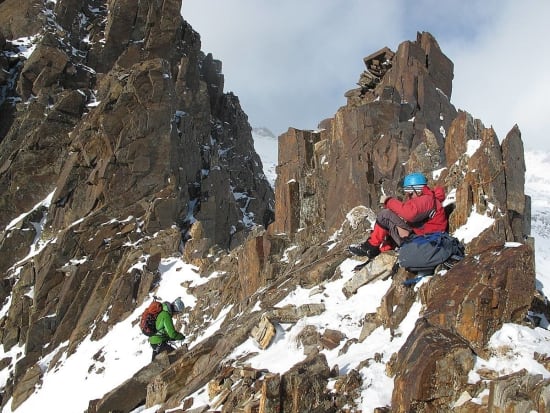
Spectacular scenery for mountaineering in the Sierra Nevada
And from there it would take several hours and lots of driving to be picked up and recover the car from the other side of the Sierra. But we were exhausted and didn't really fancy another epic like on the first day. With the weather moving in and the extreme cold, a fall caused by a strong gust of wind could have put us into a very tricky position indeed. Call it intuition, but as a mountain guide you sometimes have to follow your feelings and in this case safety seemed more important than the promise of a rewarding down hill ski after the dangerous crossing."
